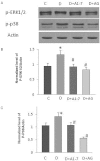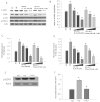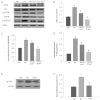Angiotensin-(1-7) inhibits epidermal growth factor receptor transactivation via a Mas receptor-dependent pathway
- PMID: 21806601
- PMCID: PMC3372724
- DOI: 10.1111/j.1476-5381.2011.01613.x
Angiotensin-(1-7) inhibits epidermal growth factor receptor transactivation via a Mas receptor-dependent pathway
Abstract
Background and purpose: The transactivation of the epidermal growth factor (EGF) receptor appears to be an important central transduction mechanism in mediating diabetes-induced vascular dysfunction. Angiotensin-(1-7) [Ang-(1-7)] via its Mas receptor can prevent the development of hyperglycaemia-induced cardiovascular complications. Here, we investigated whether Ang-(1-7) can inhibit hyperglycaemia-induced EGF receptor transactivation and its classical signalling via ERK1/2 and p38 MAPK in vivo and in vitro.
Experimental approach: Streptozotocin-induced diabetic rats were chronically treated with Ang-(1-7) or AG1478, a selective EGF receptor inhibitor, for 4 weeks and mechanistic studies performed in the isolated mesenteric vasculature bed as well as in primary cultures of vascular smooth muscle cells (VSMCs).
Key results: Diabetes significantly enhanced phosphorylation of EGF receptor at tyrosine residues Y992, Y1068, Y1086, Y1148, as well as ERK1/2 and p38 MAPK in the mesenteric vasculature bed whereas these changes were significantly attenuated upon Ang-(1-7) or AG1478 treatment. In VSMCs grown in conditions of high glucose (25 mM), an Src-dependent elevation in EGF receptor phosphorylation was observed. Ang-(1-7) inhibited both Ang II- and glucose-induced transactivation of EGF receptor. The inhibition of high glucose-mediated Src-dependant transactivation of EGF receptor by Ang-(1-7) could be prevented by a selective Mas receptor antagonist, D-Pro7-Ang-(1-7).
Conclusions and implications: These results show for the first time that Ang-(1-7) inhibits EGF receptor transactivation via a Mas receptor/Src-dependent pathway and might represent a novel general mechanism by which Ang-(1-7) exerts its beneficial effects in many disease states including diabetes-induced vascular dysfunction.
© 2011 The Authors. British Journal of Pharmacology © 2011 The British Pharmacological Society.
Figures







Similar articles
-
Transactivation of ErbB Family of Receptor Tyrosine Kinases Is Inhibited by Angiotensin-(1-7) via Its Mas Receptor.PLoS One. 2015 Nov 4;10(11):e0141657. doi: 10.1371/journal.pone.0141657. eCollection 2015. PLoS One. 2015. PMID: 26536590 Free PMC article.
-
Angiotensin II-induced migration of vascular smooth muscle cells is mediated by p38 mitogen-activated protein kinase-activated c-Src through spleen tyrosine kinase and epidermal growth factor receptor transactivation.J Pharmacol Exp Ther. 2010 Jan;332(1):116-24. doi: 10.1124/jpet.109.157552. Epub 2009 Oct 1. J Pharmacol Exp Ther. 2010. PMID: 19797620 Free PMC article.
-
Increased angiotensin II-mediated Src signaling via epidermal growth factor receptor transactivation is associated with decreased C-terminal Src kinase activity in vascular smooth muscle cells from spontaneously hypertensive rats.Hypertension. 2002 Feb;39(2 Pt 2):479-85. doi: 10.1161/hy02t2.102909. Hypertension. 2002. PMID: 11882594
-
The role of EGFR in vascular AT1R signaling: From cellular mechanisms to systemic relevance.Biochem Pharmacol. 2023 Nov;217:115837. doi: 10.1016/j.bcp.2023.115837. Epub 2023 Sep 29. Biochem Pharmacol. 2023. PMID: 37777161 Review.
-
Hijacking epidermal growth factor receptors by angiotensin II: new possibilities for understanding and treating cardiac hypertrophy.Cell Mol Life Sci. 2004 Nov;61(21):2695-703. doi: 10.1007/s00018-004-4244-3. Cell Mol Life Sci. 2004. PMID: 15549170 Free PMC article. Review.
Cited by
-
Activation of ErbB2 and Downstream Signalling via Rho Kinases and ERK1/2 Contributes to Diabetes-Induced Vascular Dysfunction.PLoS One. 2013 Jun 27;8(6):e67813. doi: 10.1371/journal.pone.0067813. Print 2013. PLoS One. 2013. PMID: 23826343 Free PMC article.
-
Muscle wasting: A review of exercise, classical and non-classical RAS axes.J Cell Mol Med. 2019 Sep;23(9):5836-5845. doi: 10.1111/jcmm.14412. Epub 2019 Jul 5. J Cell Mol Med. 2019. PMID: 31273946 Free PMC article. Review.
-
The Role of Epidermal Growth Factor Receptor Family of Receptor Tyrosine Kinases in Mediating Diabetes-Induced Cardiovascular Complications.Front Pharmacol. 2021 Aug 2;12:701390. doi: 10.3389/fphar.2021.701390. eCollection 2021. Front Pharmacol. 2021. PMID: 34408653 Free PMC article. Review.
-
Ang-(1-7)/ MAS1 receptor axis inhibits allergic airway inflammation via blockade of Src-mediated EGFR transactivation in a murine model of asthma.PLoS One. 2019 Nov 1;14(11):e0224163. doi: 10.1371/journal.pone.0224163. eCollection 2019. PLoS One. 2019. PMID: 31675376 Free PMC article.
-
Vitamin D and Its Potential Interplay With Pain Signaling Pathways.Front Immunol. 2020 May 28;11:820. doi: 10.3389/fimmu.2020.00820. eCollection 2020. Front Immunol. 2020. PMID: 32547536 Free PMC article. Review.
References
-
- Almendro V, García-Recio S, Gascón P. Tyrosine kinase receptor transactivation associated to G protein-coupled receptors. Curr Drug Targets. 2010;11:1169–1180. - PubMed
-
- Andrew A, Kathryn JW, Alison JC, Yuan Z, Richard EG, Darren JK. Inhibition of the epidermal growth factor receptor preserves podocytes and attenuates albuminuria in experimental diabetic nephropathy. Nephrology (Carlton) 2011;16:573–581. - PubMed
Publication types
MeSH terms
Substances
LinkOut - more resources
Full Text Sources
Research Materials
Miscellaneous

